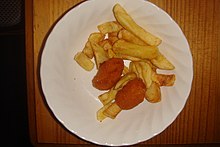Scampi
Scampi is a culinary name for some species of lobster, notably the 'true' scampi Nephrops norvegicus, and is also used as a name for a style of preparation of these lobsters and other seafood.
Variety of Lobster
Several varieties of lobsters are known as scampi. The 'true' scampi are Norway lobsters (Nephrops norvegicus), which are found in the Adriatic, parts of the western Mediterranean, and the Irish Sea, hence its name in Ireland and the United Kingdom, the Dublin Bay Prawn. The French term is langoustine. The English word refering to Scampi is Scampo.[1] It is the plural of Italian scampo, but that form is rarely used in English. The name is used loosely both in Italy and elsewhere to refer to other similar species, though some food labelling laws (in Britain, for example) define "scampi" as Nephrops norvegicus.[2]
The fleshy tail of the Norway lobster is closer in both taste and texture to lobster and crayfish than prawn or shrimp.
Method of Preparation


In both the United Kingdom and the USA, the word has come to define the method of preparation rather than the ingredient, although referring to quite different methods in the two countries.
In the United Kingdom, "scampi" refers to a dish of shelled lobster tail meat, that commonly comes prepared coated in breadcrumbs or batter, deep fried, and often served with chips, peas and Tartar sauce.[1] In the Southern Hemisphere, other species of lobster are used instead, such as Metanephrops challengeri.
In the USA, "scampi" is often the menu name for shrimp in Italian-American cuisine (the actual word for "shrimp" in Italian is gamberi). The term "Scampi", by itself, is also the name of a dish of shrimp served in garlic butter and dry white wine, served either with bread, or over pasta or rice. The word "scampi" is often construed as that style of preparation rather than an ingredient, with that preparation being called "shrimp scampi", and with variants such as "chicken scampi".
References
- Alan Davidson, Mediterranean Seafood, 1972. ISBN 0-140-46174-4
- UK fish labelling regulations
Notes
This article needs additional citations for verification. (July 2007) |
